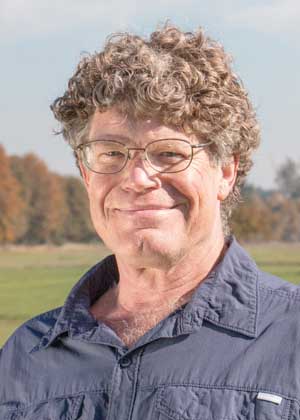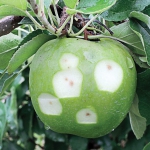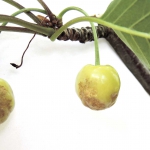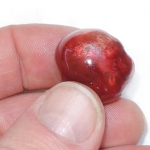Disappointing news has come out of the search to find a natural enemy for brown marmorated stinkbug. Researchers had pinned their hopes on a promising parasitic wasp from Asia, but the species won’t make it out of quarantine.
The brown marmorated stinkbug, considered a severe pest to growers in the Mid-Atlantic States, is a growing problem on the West Coast. The stinkbug, which has disrupted integrated pest management programs and cost fruit growers millions of dollars in damage, is found in more than 40 states, including tree fruit, grape, and berry growing areas in Washington and Oregon.
Oregon State University’s Dr. Peter Shearer categorizes the invasive pest as a “pending threat” for growers in eastern Washington and eastern Oregon and calls it a “big problem” for those in western Washington and western Oregon. Shearer, director of OSU’s Mid-Columbia Agricultural Research and Extension Center since 2008, was one of the first U.S. entomologists to work on the invasive stinkbug when he was at Rutgers University.
He is leading the West Coast component of a national, coordinated effort led by Dr. Tracy Leskey, scientist with the U.S. Department of Agriculture in Kearneysville, West Virginia. Dr. Betsy Beers, Washington State University, is lead entomologist for eastern Washington. The project focuses on specialty crops and recently received funding for two more years of study.
“Native biological control agents are not working,” Shearer reported during the Washington State Horticultural Association’s annual meeting. Natural enemies are needed to help reduce overwintering population numbers of brown marmorated stinkbug so that fewer would emerge in the spring.
Because of the stinkbug’s ability to overwinter in protected places and its transitory habits, chemical control has proven difficult.
Several parasitoid wasp species were collected from Asia, the brown marmorated stinkbug’s home, and brought to the United States for study. The wasps, some of which are in quarantine facilities at Corvallis, Oregon, are part of biological control research led by the U.S. Department of Agriculture.
Before any newly introduced insect can be released in the United States, researchers must first make sure it will not have a negative impact on existing environments and species.
One species was initially found to be particularly promising—Trissolcus japonicus—because it aggressively attacked brown marmorated stinkbug. Unfortunately, it also went after native stinkbug species.
Desert climate
The western sides of both Oregon and Washington are ideal areas for brown marmorated stinkbug, said Shearer. Western Washington and western Oregon have similar geography, temperate climate, overwintering sites, and alternate hosts of brown marmorated stinkbug. A diversified tree fruit and vegetable farm in Vancouver, Washington, has suffered significant economic damage from the stinkbug the last two years.
But it’s a different landscape east of the Cascade Mountain Range. There are fewer overwintering sites and alternate hosts, summers are dry and hot, winters are cold, and the region is home to sagebrush instead of mixed hardwoods, evergreen and perennial trees, and dense, riparian bushes.
Studies have shown that brown marmorated stinkbug can have two generations per summer in most parts of the West Coast. In the past two years, caged stinkbug trials resulted in two summer generations in Oregon’s Hood River, Medford, and Hermiston, said Shearer.
Researchers have studied fruit damage inflicted by brown marmorated stinkbug at different fruit development stages to better understand fruit susceptibility.
For apples, USDA’s Leskey found that feeding on fruit early in the season caused minor dimpling on fruit, but it caused significant damage if stinkbugs came late in the season.
The brown marmorated stinkbug has a piercing stylet through which it sucks juices from fruit and vegetative material. Damage is caused by sucking and the stinkbug’s deposit of enzymes in fruit and vegetative tissues.

Peter Shearer
While Shearer was at Rutgers University, he studied stinkbug damage on peaches.
“They love peaches,” he said. “Peaches are really susceptible to stinkbug and are a preferred host.”
While in New Jersey, he observed brown marmorated stinkbug coming into peach orchards early in the season while fruit were young and staying there throughout the
season. Small peaches often fell off the tree because of the early season feeding, but fruit that stayed on the tree had cavities under the skin. Stinkbugs feeding close to harvest resulted in pithy spots on fruit. Stinkbug were also found feeding on peach tree trunks and terminals or shoots.
The Mid-Atlantic region, where damage has occurred, is not a big producer of pears and sweet cherries, so, to learn about potential damage to those crops, Shearer conducted caged studies of male stinkbugs in Hood River. He used males because he didn’t want to risk egg laying by females.
He placed stinkbugs in caged pear trees in June and at harvest to compare differences in damage. Fruit from early season feeding had hard cells compared to pithy, decayed spots resulting from feeding at harvest. Fruit from both feeding times were placed in cold storage and examined one month later. “The damage gets manifested during storage,” Shearer said. “Fruit that looked sound going in came out decayed.”
In his sweet cherry study, he put male stinkbugs in caged cherry trees when fruit were straw colored and followed the fruit through harvest. Within a week of exposure, fruit showed damage and at harvest, fruit had corky spots. “The timing of early June is when they start coming out en masse,” he said.
Trapping and lures
Effective traps and lures are still works in progress. “There’s a lot of work going on, but we’re not there yet,” he said.
The difficulty with lures is finding one that attracts brown marmorated stinkbug early in the season. Current lures, including USDA’s new #10 lure, works mainly in the fall and catches few stinkbugs in the spring.
Springtime control is important because that’s when they are most vulnerable and easiest to kill. “When the big stinkbug tanks come in later in the summer, they are the ones that do major damage,” said Shearer, noting that East Coast growers treat the pest as a perennial and spray routinely. “There are efficacious products out there, but the chemicals are short-lived. If you don’t spray stinkbug directly, it takes more sprays and effort to kill them.”
Researchers also continue to fine-tune trap design.
“The lures and traps are changing all the time,” he said. “More research is needed to be able to relate numbers of stinkbug in traps to damage in the field. As we develop standardized lures and traps, we’ll be able to improve things like the threshold number.”
Ultimately, Shearer believes that biological control will be the saving grace for those battling brown marmorated stinkbug. •









True that pheromone traps are more effective in the fall than the spring; however, when pheromone traps are placed within the center of highly effective trap plants, trapping efficiency can be increased by a factor of 2 to 3. Unfortunately still not effective in control, but this technique can reduce some damage.